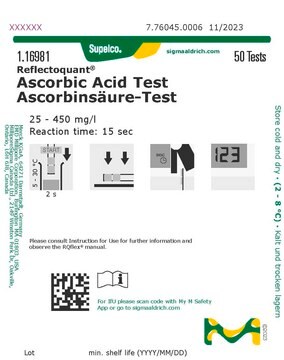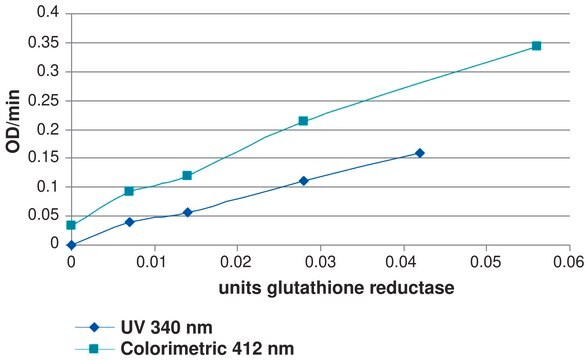MAK074
Ascorbic Acid Assay Kit
sufficient for 100 colorimetric or fluorometric tests
Synonim(y):
Vitamin C Assay Kit
Zaloguj sięWyświetlanie cen organizacyjnych i kontraktowych
About This Item
Kod UNSPSC:
12161503
NACRES:
NA.84
Polecane produkty
zastosowanie
sufficient for 100 colorimetric or fluorometric tests
metoda wykrywania
colorimetric
fluorometric
temp. przechowywania
−20°C
Opis ogólny
The new Ascorbic Acid Assay Kit, MAK505, is now available! Ascorbic Acid, also known as Vitamin C, is a six-carbon lactone produced by plants and some animal species but not by humans and other primates. Ascorbic acid functions as an enzymatic cofactor for multiple enzymes, serving as an electron donor for monooxygenases and dioxygenases. Ascorbic acid also functions as a powerful antioxidant, particularly in regards to reactive oxygen species.
Przydatność
Suitable for use with biological fluids, food samples, and growth media. Proteins present in the sample can interfere with this assay. Protein containing samples are best analyzed using the Ascorbic Acid Assay II (MAK075). Alternatively, samples can be deproteinized using a 10 kDa Molecular Weight Cut-Off Spin Filter.
Zasada
In this assay, Ascorbic Acid concentration is determined by a coupled enzyme reaction, which results in a colorimetric (570 nm)/fluorometric (λex = 535/ λem = 587 nm) product, proportional to the ascorbic acid present.
This page may contain text that has been machine translated.
zastąpiony przez
Numer produktu
Opis
Cennik
Hasło ostrzegawcze
Danger
Zwroty wskazujące rodzaj zagrożenia
Zwroty wskazujące środki ostrożności
Klasyfikacja zagrożeń
Eye Irrit. 2 - Resp. Sens. 1 - Skin Sens. 1
Kod klasy składowania
10 - Combustible liquids
Temperatura zapłonu (°F)
188.6 °F - closed cup
Temperatura zapłonu (°C)
87 °C - closed cup
Certyfikaty analizy (CoA)
Poszukaj Certyfikaty analizy (CoA), wpisując numer partii/serii produktów. Numery serii i partii można znaleźć na etykiecie produktu po słowach „seria” lub „partia”.
Masz już ten produkt?
Dokumenty związane z niedawno zakupionymi produktami zostały zamieszczone w Bibliotece dokumentów.
Klienci oglądali również te produkty
Giulia Costanzo et al.
Antioxidants (Basel, Switzerland), 11(2) (2022-02-26)
In this work, we assess the potential of waste products of Phlegrean mandarin (Citrus reticulata Blanco), namely seeds and peel, to be reutilized as a source of bioactive compounds beneficial for the human diet. Starting from the evidence that the
Giulia Costanzo et al.
Antioxidants (Basel, Switzerland), 9(6) (2020-06-18)
Peel, pulp and seed extracts of three mandarin varieties, namely Phlegraean mandarin (Citrus reticulata), Kumquat (Citrus japonica), and Clementine (Citrus clementina) were compared and characterised in terms of photosynthetic pigment content, total polyphenols amount, antioxidant activity and vitamin C to
Ermenegilda Vitale et al.
Plants (Basel, Switzerland), 10(5) (2021-05-01)
This paper evaluates the combined effect of biostimulant and light quality on bioactive compound production and seedling growth of soybean (Glycine max L. Merrill) plants. Germinated seeds pre-treated with different concentrations (0.01%, 0.05%, 0.5%) of an amino acid-based biostimulant were
Stephanie P DiTroia et al.
Nature, 573(7773), 271-275 (2019-09-06)
Development is often assumed to be hardwired in the genome, but several lines of evidence indicate that it is susceptible to environmental modulation with potential long-term consequences, including in mammals1,2. The embryonic germline is of particular interest because of the
Gabriela Rodríguez-Fuentes et al.
Comparative biochemistry and physiology. Toxicology & pharmacology : CBP, 172-173, 19-25 (2015-05-06)
Organophosphate pesticides cause irreversible inhibition of AChE which leads to neuronal overstimulation and death. Thus, dogma indicates that the target of OP pesticides is AChE, but many authors postulate that these compounds also disturb cellular redox processes, and change the
Nasz zespół naukowców ma doświadczenie we wszystkich obszarach badań, w tym w naukach przyrodniczych, materiałoznawstwie, syntezie chemicznej, chromatografii, analityce i wielu innych dziedzinach.
Skontaktuj się z zespołem ds. pomocy technicznej





